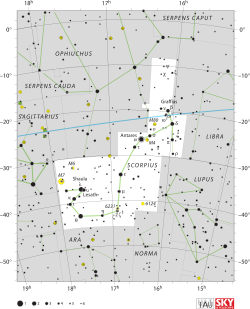Antares
| Observation data Epoch J2000 Equinox J2000 |
|
|---|---|
| Constellation | Scorpius |
| Right ascension | 16h 29m 24.45970s |
| Declination | −26° 25′ 55.2094″ |
| Apparent magnitude (V) | +0.96 |
| Characteristics | |
| Evolutionary stage | Red supergiant |
| Spectral type | M1.5Iab + B2.5V |
| U−B color index | +1.34 |
| B−V color index | +1.83 |
| Variable type | Lc |
| Astrometry | |
| Radial velocity (Rv) | −3.4 km/s |
| Proper motion (μ) |
RA: −12.11 mas/yr Dec.: −23.30 mas/yr |
| Parallax (π) | 5.89 ± 1.00mas |
| Distance | approx. 550 ly (approx. 170 pc) |
| Absolute magnitude (MV) | −5.28 |
| Details | |
| A | |
| Mass | 12.4 M☉ |
| Radius | 883 R☉ |
| Luminosity | 57,500 L☉ |
| Surface gravity (log g) | 0.1 cgs |
| Temperature | 3400 ± 200 K |
| Rotational velocity (v sin i) | 20 km/s |
| B | |
| Mass | 7.2 M☉ |
| Radius | 5.2 R☉ |
| Surface gravity (log g) | 3.9 cgs |
| Temperature | 18,500 K |
| Rotational velocity (v sin i) | 250 km/s |
| Other designations | |
| Database references | |
| SIMBAD | data |
Antares (/ænˈtɑːriːz/), also designated Alpha Scorpii (α Scorpii, abbreviated Alpha Sco, α Sco), is the fifteenth-brightest star in the night sky; the brightest star in the constellation of Scorpius, and is often referred to as "the heart of the scorpion". Along with Aldebaran, Regulus, and Fomalhaut, Antares comprises the group known as the 'Royal stars of Persia'. It is one of the four brightest stars near the ecliptic.
Distinctly reddish when viewed with the unaided eye, Antares is a red supergiant of spectral type M0.5Iab and is one of the largest and most luminous observable stars. It is a slow irregular variable star with the quoted magnitude of +0.96. Antares is the brightest, most massive, and most evolved stellar member of the nearest OB association (the Scorpius–Centaurus Association). Antares is a member of the Upper Scorpius subgroup of the Scorpius–Centaurus Association, which contains thousands of stars with mean age 11 million years at a distance of approximately 145 parsecs (470 ly).
...
Wikipedia

